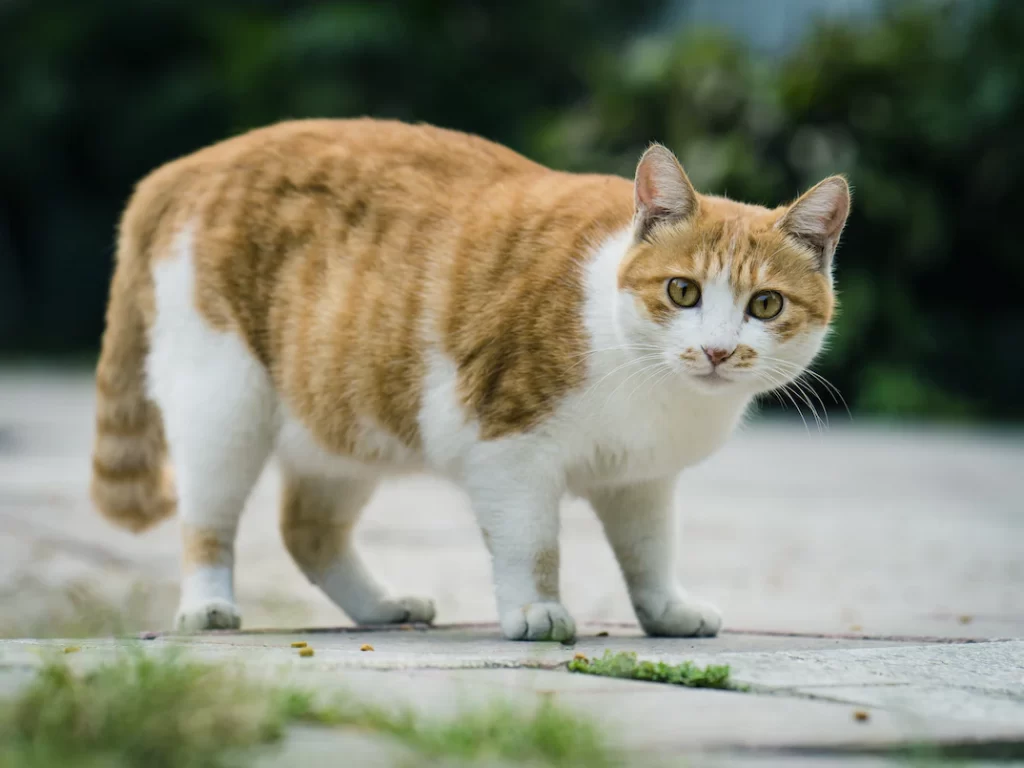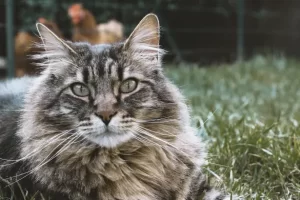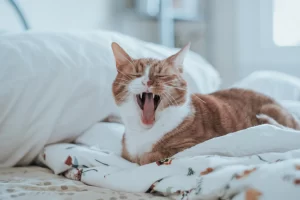Last updated on February 18th, 2023 at 06:37 pm

The cases of cat obesity have been on the rise in recent years. It is estimated that between 0.2% and 1% of cats will be diagnosed with diabetes during their lifetime. The increase in cases of diabetes is largely attributed to unhealthy diets and lack of exercise. According to the annual state of pet health report released by Banfield Pet Hospital, the occurrence of diabetes in cats rose by over 18% from 2006 to 2015. One of the biggest risk factors for diabetes in cats is obesity. However, it is not the only risk factor. So how can you know if your feline has diabetes? In this article, we will discuss cat diabetes signs.
What exactly is cat diabetes?
Diabetes mellitus, popularly known as cat diabetes is a condition where the cat cannot produce or respond to insulin hormones resulting in a rise in sugar levels.
Insulin is a hormone that is necessary to convert sugar, starches, and other food into energy. Without enough insulin, the cat’s body cannot process the sugar and starches properly, leading to an increase in blood sugar levels.
Just like humans, cat cells also need energy in form of glucose to function optimally. But glucose in the blood cannot be useful without the help of insulin – a hormone produced by the pancreas. This crucial hormone plays a crucial role in opening the gate to the cells. Insulin is usually attached to the cell and determines the right time to absorb glucose. Proper absorption of glucose is crucial for the normal function of crucial organs such as the livers and muscles.
Cats can suffer from two types of diabetes namely type 1 diabetes and type 2 diabetes. Diabetes is a metabolic disorder that affects a cat’s ability to regulate blood sugar. While there are many different types of diabetes, the two most common in cats are type 1 diabetes and type 2 diabetes.
Type 1 diabetes, also known as insulin-dependent diabetes, is an autoimmune disorder in which the body’s immune system mistakenly attacks and destroys the insulin-producing cells in the pancreas. Without insulin, the body is unable to properly use and store glucose, resulting in high levels of sugar in the blood. Type 1 diabetes is most common in young cats, and is often associated with obesity, inadequate nutrition, and stress.
Type 2 diabetes, also known as non-insulin dependent diabetes, is a condition in which the body does not produce enough insulin or is unable to properly use the insulin it produces. It is most commonly seen in older cats and is often associated. Most cats usually suffer from type 2 diabetes. The occurrence of type 1 diabetes is rare.
What is the main cause of diabetes in cats?
Now that you know what diabetes is, you are probably curious to know its main causes. There is no one direct cause of diabetes in cats. However, some factors increase the risk of your feline developing diabetes as discussed below.
- Obesity
One of the biggest risk factors for diabetes is obesity. Cats that are overweight and obese usually secrete too much of certain hormones and not enough of others. As result, their bodies are usually not able to respond effectively to insulin. When cats become overweight, their bodies become less efficient at producing and utilizing insulin, which is needed to regulate their blood sugar levels. As a result, their blood sugar levels remain high, and diabetes develops. If a cat is overweight and/or inactive, it is important to get them on a healthy diet and exercise plan in order to prevent diabetes.
Physical activity: When cats become overweight, their bodies become less sensitive to insulin, the hormone responsible for regulating the amount of sugar in their blood. This can result in their blood sugar levels becoming too high, which can lead to the onset of diabetes.
- Feeding your cat foods that are high in carbohydrates
Feeding your cat food that is high in carbohydrate also increase the risk of the cat developing diabetes. Unlike humans whose digesting system can handle carbohydrates without any issues, cats are carnivores, meaning that their metabolism responds well to a diet that is high in protein and low in carbs. So, if you feed your feline with a lot of carbohydrates, then her blood glucose level will increase drastically, and this can lead to a reduction in the secretion of insulin.
- Untreated diseases
Your cat can also develop type 2 diabetes if other diseases remain untreated for an extended period of time. For instance, an overactive adrenal gland that remains untreated for a long period can cause your cat to develop diabetes. Other untreated diseases that may contribute to your cat developing diabetes include a chronically inflamed pancreas, an overactive thyroid gland, and acromegaly (a condition where the pituitary gland produces a lot of growth hormone). It is also important to note that male cats are more likely to develop diabetes than female cats.
Cat diabetes signs
Signs of cat diabetes can be hard to spot, especially if you are not keen. That is why most cat owners usually take their cats to the vet when things are really bad. Knowing how to correctly identify the sign of diabetes can save your cat’s life. Now, let’s take a look at the signs of diabetes in cats.
- Increased urination and excessive thirst
One of the top symptoms of diabetes in cats is increased urination. If your cat makes more frequent visits to the litter than it used to, then it could be because it is suffering from type 2 diabetes. Monitor your feline closely to see if it fills the litter box more often than it did. Urinating outside the litter is also a sign to watch out for.
According to Dr. Murithi, high blood sugar level usually affects the ability of the kidneys to reabsorb water as it filters when a cat is suffering from diabetes. As a result, the cat is forced to urinate more to get rid of that water. Increased urine production may even force your feline to start urinating outside the litter box. So, monitor how your cat urinates. If her urinating frequency has increased or the urine appears to be less concentrated, you should take her to the vet for further diagnosis to check if she has diabetes.
- Increased thirst
Another comma symptom of diabetes in cats is increased thirst. If your cat’s water intake has increased drastically over the last few days, then that could be a sign that she has diabetes. As diabetes in your cat become more serious, it will start drinking more water than usual to compensate for the one that it is being lost through urination.
As mentioned earlier, when your cat’s blood sugar level is too high, it may affect the ability of the kidney to reabsorb water resulting in increased urination. The cat, on the other hand, will respond by drinking more water in order to prevent dehydration. So, if your cat drinks more water than usual, you should take her to the vet for further inspection.
- Weight loss
Another one of cat diabetes signs that indicates your cat has diabetes is drastic weight loss. It is one of the most common and also the easiest symptom to spot. If your cat is eating as usual but still losing weight, then she could be suffering from diabetes. When insulin levels are high they force glucose molecules to form glycosylated structures that may damage lipids and protein in cells thus compromising cellular function.
The cat’s body responds to this by breaking down fat and muscles, leading to weight loss. So, if your cat is losing weight fast despite eating that same amount of food, you should take it to the vet for a thorough checkup.
- Unkempt hair coat
Another key sign of diabetes in cats is an unkempt hair coat. There are a number of things that could be making your feline have an unkempt hair coat. First of all, diabetes usually deprives the body of much-needed energy. This means that major body organs such as the skin will not have sufficient energy to function optimally.
Lack of energy can result in excessive dandruff and flaking, especially along the back. Another reason why your cat has an unkempt coat is because of lethargy and malaise which is very common in cats that are suffering from diabetes. Lack of energy can make your cat not want to groom herself.
- Increase appetite
Increased appetite could also be a sign that your feline is suffering from diabetes. If your cat seems to want more food than what it is used to, then it means that the body is not getting sufficient energy.
Insulin plays a crucial role in supplying the cells with glucose, which, in turn, powers the cat’s crucial organs. When insulin is not sufficient or is unavailable, the cell will not be able to obtain the much-needed energy. As a result, the brain sends a signal to consume more energy, resulting in increased appetite.
- Lack of energy
Cats are naturally energetic and playful. So, if you notice that your cat is becoming lethargic and often lack energy, then she could be suffering from diabetes. The reason why the cat lacks energy is because of the buildup of excessive glucose in the body.
As mentioned earlier, glucose from the bloodstream can only enter the cells through the help of insulin. If the insulin that signals the cell to allow glucose is too low, then it will not be able to allow the entry of glucose into the cell for energy, resulting in excessive glucose buildup in the bloodstream. Having high blood sugar in the body for a long will make your cat feel malaise and lethargic.
- Vomiting
High blood sugar levels usually affect many parts of the cat’s body. As a result, cats with diabetes usually experience nausea that causes them to vomit frequently. If your cat is vomiting a lot, you should call your vet for advice.
Diabetes treatment in cats
Diabetes mellitus has no cure, but it can be managed through effective treatment. The first process to treating diabetes in a cat is determining cat diabetes signs and causes. For instance, if the main trigger of diabetes is the medication that the cat has been using, then the vet will recommend that you stop giving your cat that particular medicine until further notice. Another trigger for diabetes in cats is obesity. If your cat is obese, the vet will recommend that you check the cat’s diet to help reduce weight.
Diet is the first line of treatment for cats with diabetes. Feeding a balanced, nutritious diet with a moderate amount of carbohydrates is important for managing diabetes. Avoiding foods that are high in sugar, such as dry cat food, is essential. A veterinarian can recommend an appropriate diet plan for the cat. Medications are also important in treating diabetes in cats. Insulin injections are the most common form of medication used to control blood sugar levels. Regular injections of insulin are necessary to regulate glucose levels in the body.
Other medications, such as antibiotics and anti-inflammatory drugs, may be prescribed to help manage any concurrent conditions. This means that you may need to take your cat to a vet clinic several times for insulin injections until her condition stabilizes. In addition to diet and medications, lifestyle modifications are also important for treating diabetes in cats. Indoor cats should be given more opportunities to exercise, such as playing with toys or going for regular walks. Outdoor cats should be kept indoors to reduce the risk of catfights and other dangers. Keeping the cat at a healthy weight is also important.
Your cat may also need to be given insulin injections to control diabetes. This means that you may need to take your cat to a vet clinic several times for insulin injections until her condition stabilizes. The vet may also recommend that you purchase a home monitoring kit to monitor your cat’s glucose levels. Your feline may be given two injections of insulin until she stabilizes. Your vet will determine the appropriate dosage and the type of insulin to administer to your cat.
It is very important for your cat to receive an appropriate insulin level. If she receives too much insulin, her blood sugar level may drop to dangerously low levels and this may cause shaking, lethargy, unsteadiness, weakness, and even convulsions. That is why you need to be careful and ensure that your cat receives the right amount of insulin dosage.
Final thoughts
The treatment of diabetes in cats is a complex and challenging process. It requires a commitment from the owner and veterinarian to ensure the cat’s health and well-being is maintained. The goal of treatment is to maintain normal blood glucose levels as close to normal as possible, while minimizing the risk of complications. Treatment typically involves a combination of diet, exercise, and insulin therapy. Diet and exercise should be tailored to the individual needs of the cat and monitored closely. Insulin therapy is often necessary and should be closely monitored by a veterinarian.
In addition to diet and exercise, it is important to ensure the cat is receiving adequate nutrition and hydration. Regular monitoring of glucose levels and adjusting the insulin dosage as needed is also essential. With proper treatment, diabetes in cats can be managed and the cat can live a long and healthy life. It is important to work closely with your veterinarian to ensure the best possible outcome for your cat.


